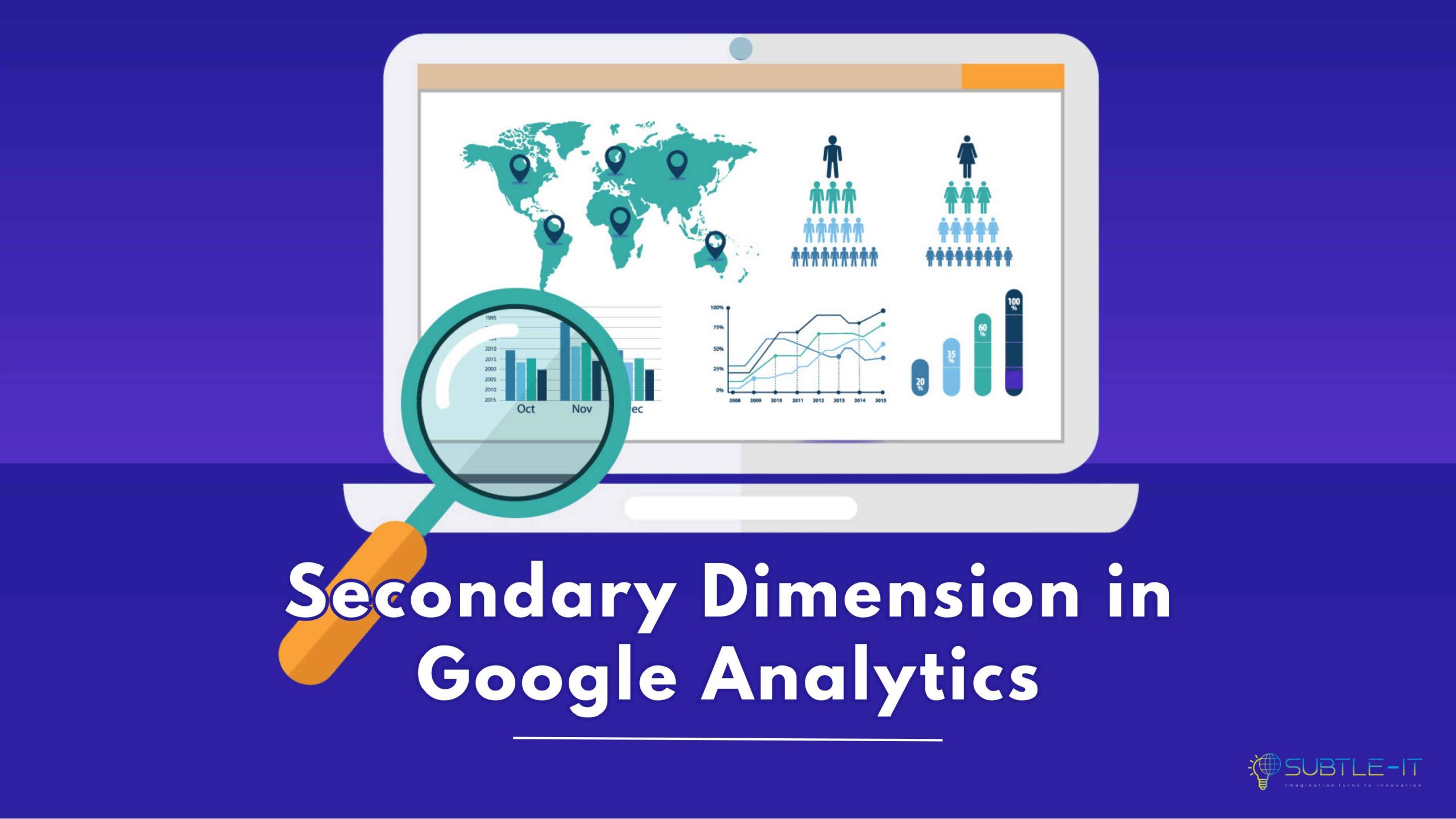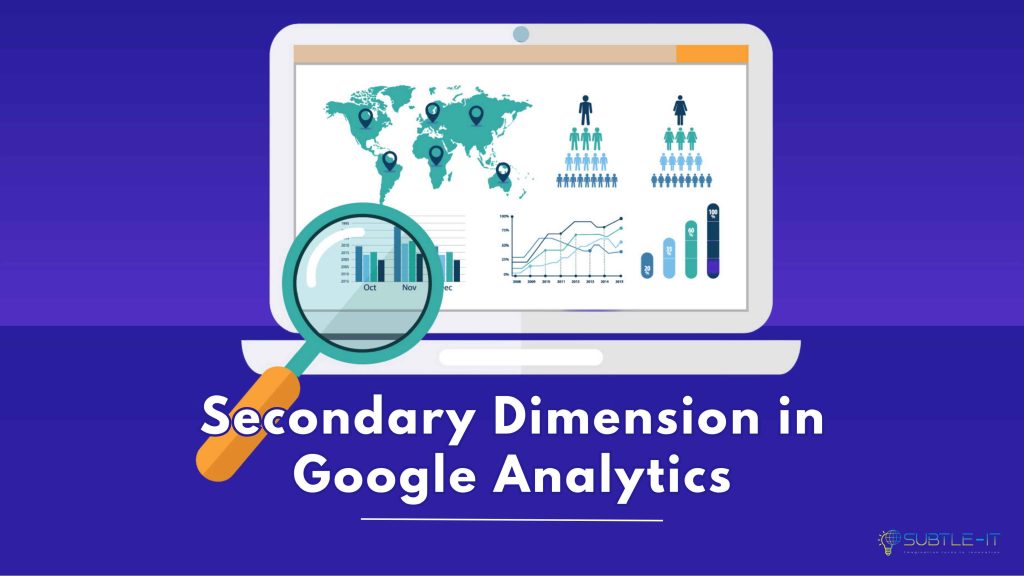In the realm of digital analytics, Google Analytics stands as a powerhouse, providing invaluable insights into website performance and user behavior. One of its key features, often overlooked, is the “secondary dimension.” In this article, we’ll delve into what a secondary dimension is in Google Analytics and how you can leverage it to gain deeper insights into your data for improved decision-making and enhanced online performance.
What is a Secondary Dimension in Google Analytics?
Imagine Google Analytics as a treasure trove of data, with primary dimensions acting as your first layer of exploration. Primary dimensions include metrics like page views, traffic sources, and devices. But what if you want to uncover more? This is where secondary dimensions come into play.
A secondary dimensions add an extra layer of information to your primary report. It allows you to cross-reference data from a different angle, providing context and depth to your analysis. In essence, secondary dimensions enable you to see how two dimensions interact, revealing patterns and correlations that might have remained hidden otherwise.
How Can Businesses Benefit from Using Analytics on Their Website – Website Analytics
Unveiling Insights with Secondary Dimensions With Example
Let’s bring this concept to life with an example. Imagine you’re the digital marketing manager of an e-commerce website that sells clothing and accessories. Your team has been actively running various marketing campaigns to drive traffic to your site. You’re analyzing the effectiveness of these campaigns using Google Analytics.
As you dive into your report showcasing the traffic sources (primary dimension) that led users to your website, you’re intrigued by the significant traffic influx from social media platforms. Your primary data reveals that Facebook, Instagram, and Twitter are the top three sources of traffic.
Now, you’re curious about how user engagement varies based on the devices they’re using to access your website when they come from these social media channels. This is where the power of a secondary dimension like “Device Category” comes into play.
By adding “Device Category” as your secondary dimension, you’ll be able to uncover insights that go beyond the basic traffic numbers. The report could now look something like this:
| Traffic Source | Device Category | Page Views | Average Time on Page |
| Desktop | 8,500 | 2:45 | |
| Mobile | 5,200 | 1:55 | |
| Desktop | 6,200 | 2:10 | |
| Mobile | 7,800 | 2:30 | |
| Desktop | 3,800 | 2:05 | |
| Mobile | 4,500 | 1:40 |
With this enriched data, you can draw insightful conclusions. For instance, you notice that users coming from Instagram tend to have a longer average time on page, regardless of whether they’re using desktop or mobile devices. This might suggest that your Instagram content is particularly engaging and resonates well with your audience.
Conversely, you see that users from Twitter spend less time on your pages compared to other platforms. This insight prompts you to reevaluate your Twitter marketing strategy, potentially optimizing your Twitter-specific content to increase engagement.
By skillfully employing the secondary dimension “Device Category,” you’ve not only uncovered how different social media platforms contribute to your traffic but also how user engagement varies based on device type. This newfound knowledge empowers you to refine your marketing approach, create more tailored content, and ultimately enhance the overall user experience on your e-commerce website.
Leveraging Secondary Dimensions
To harness the power of secondary dimensions, follow these simple steps:
Select Your Primary Dimension: Begin by selecting the primary dimension you want to analyze. This could be anything from traffic sources to landing pages.
Click “Secondary Dimension”: Once you’ve chosen your primary dimension, locate the “Secondary Dimension” button within your report. Click on it to open a dropdown menu of available secondary dimensions.
Choose Your Secondary Dimension: Scroll through the options and select the secondary dimension that complements your primary data analysis. This could be “City,” “Device Type,” “Browser,” and more.
Analyze and Interpret: As you explore the data, pay attention to trends, patterns, and correlations that emerge between the primary and secondary dimensions. These insights can inform your marketing strategies, content creation, and user experience enhancements.
The Benefits of Secondary Dimensions
Secondary dimensions offer several benefits for website owners and marketers:
Deeper Insights: Gain a more comprehensive understanding of how different dimensions interact and influence each other.
Enhanced Decision-Making: Use the insights from secondary dimensions to refine your strategies and tailor your efforts to specific user segments.
Targeted Optimization: Fine-tune your content, ads, and user experience based on data-driven insights from cross-referenced dimensions.
FAQ on Secondary Dimensions in Google Analytics
How does a secondary dimension enhance data analysis?
A secondary dimensions adds extra context to your primary data, allowing you to see how different dimensions interact. This can uncover correlations, trends, and variations that provide a more comprehensive understanding of user behavior and website performance.
How can I add a secondary dimension to my Google Analytics report?
To add a secondary dimension, follow these steps:
Choose your primary dimension (e.g., traffic sources).
Locate the “Secondary Dimension” button in your report.
Click on the button and choose the secondary dimension you want to add (e.g., device category).
Your report will now display data that combines both dimensions, providing deeper insights.
What’s the benefit of using secondary dimensions?
Secondary dimensions offer several benefits, including:
Deeper Insights: By combining dimensions, you gain a more nuanced understanding of user behavior and patterns.
Informed Decisions: Insights from secondary dimensions guide better decision-making in marketing, content creation, and user experience optimization.
Tailored Strategies: Data from secondary dimensions helps you tailor strategies to specific user segments, improving engagement and conversions.
Can you provide an example of using a secondary dimension in Google Analytics?
Certainly! Imagine you’re analyzing traffic sources and want to understand user engagement based on devices. Adding the “Device Category” secondary dimension reveals data like page views and average time on page for desktop and mobile users coming from various sources like Facebook, Instagram, and Twitter.
How does the “Device Category” secondary dimension help businesses?
The “Device Category” secondary dimension helps businesses understand how user engagement varies based on the devices visitors use. This insight can guide responsive design, content optimization, and marketing efforts tailored to different devices and user behaviors.
Q7: Can I use multiple secondary dimensions in a single report?
No, Google Analytics allows you to add only one secondary dimension at a time. If you want to analyze multiple dimensions, consider creating different reports with the desired primary and secondary dimensions.
Are secondary dimensions useful for all types of websites?
Yes, secondary dimensions can provide insights for various types of websites, including e-commerce, blogs, portfolio sites, and more. Any site seeking to understand user behavior and optimize performance can benefit from leveraging secondary dimensions.
Are there predefined secondary dimensions in Google Analytics?
Yes, Google Analytics offers a range of predefined secondary dimensions, such as “City,” “Browser,” “Source/Medium,” “Landing Page,” and more. These dimensions help you explore different aspects of user interaction.
How often should I use secondary dimensions in my analysis?
The frequency of using secondary dimensions depends on your analytical goals. If you’re aiming to uncover specific insights, use secondary dimensions whenever necessary to gain a comprehensive understanding of your data.
Remember, secondary dimensions can significantly enhance your data analysis, so don’t hesitate to explore and experiment with them to extract valuable insights from your Google Analytics reports.
In conclusion, a secondary dimension in Google Analytics is a powerful tool that unlocks a new layer of insights within your data. By examining your primary data from multiple perspectives, you can uncover patterns, trends, and correlations that guide smarter decisions and fuel your website’s success. Embrace the potential of secondary dimensions, and watch as your analytics journey takes on a whole new dimension of depth and effectiveness.
-
 What is a Secondary Dimension in Google Analytics?- Deeper Insights
What is a Secondary Dimension in Google Analytics?- Deeper Insights -
 How Can Businesses Benefit from Using Analytics on Their Website - Website Analytics
How Can Businesses Benefit from Using Analytics on Their Website - Website Analytics -
 Website Audit Service: Complete Guide and Checklist
Website Audit Service: Complete Guide and Checklist -
 10 Steps to Building a Successful Business Website
10 Steps to Building a Successful Business Website -
 Best 5 Tips for Speeding Up WordPress Website with the WP Rocket Plugin
Best 5 Tips for Speeding Up WordPress Website with the WP Rocket Plugin



